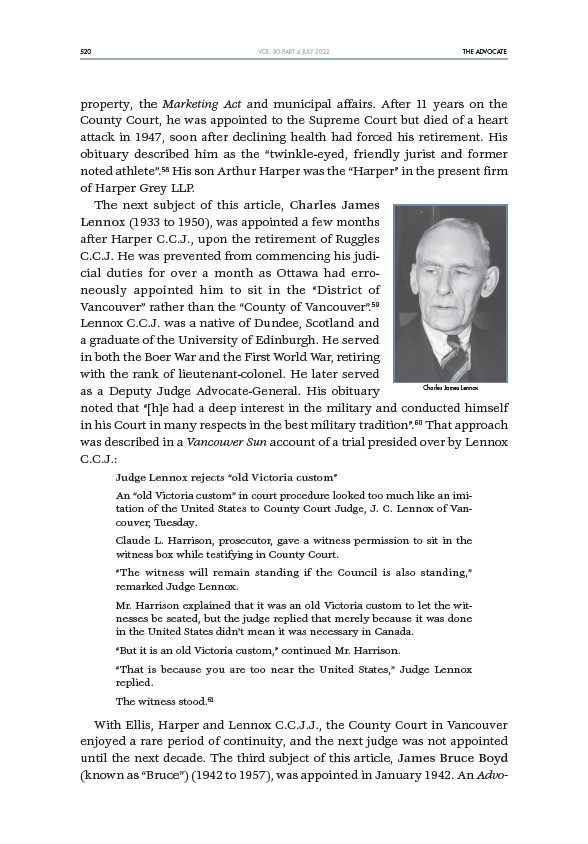
520 THE ADVOCATE
VOL. 80 PART 4 JULY 2022
property, the Marketing Act and municipal affairs. After 11 years on the
County Court, he was appointed to the Supreme Court but died of a heart
attack in 1947, soon after declining health had forced his retirement. His
obituary described him as the “twinkle-eyed, friendly jurist and former
noted athlete”.58 His son Arthur Harper was the “Harper” in the present firm
of Harper Grey LLP.
The next subject of this article, Charles James
Lennox (1933 to 1950), was appointed a few months
after Harper C.C.J., upon the retirement of Ruggles
C.C.J. He was prevented from commencing his judicial
duties for over a month as Ottawa had erroneously
appointed him to sit in the “District of
Vancouver” rather than the “County of Vancouver”.59
Lennox C.C.J. was a native of Dundee, Scotland and
a graduate of the University of Edinburgh. He served
in both the Boer War and the First World War, retiring
with the rank of lieutenant-colonel. He later served
as a Deputy Judge Advocate-General. His obituary
Charles James Lennox
noted that “he had a deep interest in the military and conducted himself
in his Court in many respects in the best military tradition”.60 That approach
was described in a Vancouver Sun account of a trial presided over by Lennox
C.C.J.:
Judge Lennox rejects “old Victoria custom”
An “old Victoria custom” in court procedure looked too much like an imitation
of the United States to County Court Judge, J. C. Lennox of Vancouver,
Tuesday.
Claude L. Harrison, prosecutor, gave a witness permission to sit in the
witness box while testifying in County Court.
“The witness will remain standing if the Council is also standing,”
remarked Judge Lennox.
Mr. Harrison explained that it was an old Victoria custom to let the witnesses
be seated, but the judge replied that merely because it was done
in the United States didn’t mean it was necessary in Canada.
“But it is an old Victoria custom,” continued Mr. Harrison.
“That is because you are too near the United States,” Judge Lennox
replied.
The witness stood.61
With Ellis, Harper and Lennox C.C.J.J., the County Court in Vancouver
enjoyed a rare period of continuity, and the next judge was not appointed
until the next decade. The third subject of this article, James Bruce Boyd
(known as “Bruce”) (1942 to 1957), was appointed in January 1942. An Advo-